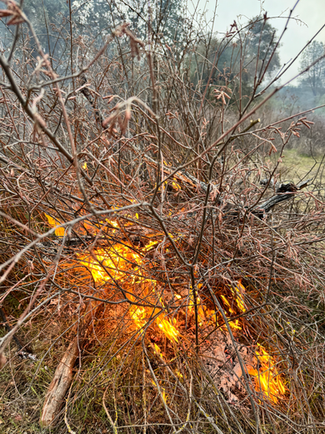Alliance Team Members Participate in the JK Estate Cultural Burn Ceremony and Workshop hosted by the North Fork Mono Tribe and Chairman Ron Goode
- Climate Science Alliance

- Mar 25, 2024
- 3 min read
Updated: Jun 13, 2024
Last month, Marlene’ Dusek, Indigenous Land Stewardship Coordinator, and Will Madrigal, Tribal Capacities and Partnerships at the Climate Science Alliance traveled to Me-Wuk (Southern Sierra Miwok) territory where they were invited to participate in a cultural burning workshop with Chairman Ron Goode, the North Fork Mono Tribe, and community partners. Hear about Marlene’ and Will's experience and how this training uplifts the Alliance’s fire stewardship programming on today’s blog!

Photo by Kimberly Avalos
In February 2024, the Climate Science Alliance was able to sponsor and send Indigenous Land Stewardship Coordinator, Marlene’ Dusek, and Tribal Capacities and Partnerships Lead, Will Madrigal Jr., to participate and contribute to a cultural ceremony and burn on Me-wuk (Southern Sierra) lands. As a part of the J.K. Estate RX Cultural Burning Workshop hosted by Chairman Ron Good, Climate Science Alliance Cultural Burning Advisor, and the North Fork Mono Tribe, the Climate Science Alliance was happy to be a sponsor for the workshop and for our team to learn from and support this good work. Our team went on this journey to connect with other Tribal nations and share and learn from one another to apply to the Alliance’s role in supporting the Southern California Interagency Fire and Fuels Cadre and future Stewardship Pathways training.

“Cultural fire is not about fire, cultural fire is about community”
- Chairman Ron Goode, North Fork Mono Tribe
Photo by Marlene' Dusek
The team was able to help in cultural ecological restoration efforts and worked side-by-side with fellow Indigenous fire-culture bearers and professionals, building new relationships and exchanging information on future collaborations with Native practitioners. Together, participants worked as teams to utilize lessons learned during the 3-day workshop into the application and accomplish of goal’s of putting good fire on the land. This included helping weavers burn sour berry or sumac for good, healthy basket materials and also helped with burning, pruning, and clearing of the build-up of vegetation so that elders could have easier access to their gathering patches.
Photos by Kimberly Avalos (left) and Marlene' Dusek (right)
This workshop brought together various volunteers from the local Tribal community and practitioners, Tribal elders, Tribal youth, other Tribes, and cultural burners. It also brought together various college and university reps and students from UC Berkeley, UC Davis, Sonoma State, Santa Rosa CC, Fresno State, Oregon State, UC Merced, and the University Montana. While also including various State and Federal agencies and National and local organizations.
Fire is and always will be an essential tool and medicine to Tribal nations as a healer of all community. We honor Chairman Ron Goode as a teacher and advisor to the Climate Science Alliance and all of the work he has done to uplift cultural fire and to teach the next generation of Indigenous fire culture bearers and professionals. “We’re not firefighters. We’re burners, professional burners,” said by Ron Goode.
Photos by Kimberly Avalos (left) and Marlene' Dusek (right)
“The revitalization of cultural burning is a priority for many Native American tribes and for agencies and organizations that recognize the cultural and ecological importance of this practice. Traditional fire practitioners are working to resist the impact of settler colonialism and reestablish cultural burning to promote traditional foods and materials, exercise their sovereignty in land management, and strengthen their community's cultural, physical, and emotional well-being. Despite broad support for cultural burning, the needs of practitioners are often poorly understood by non-Native people, limiting the potential for productive cross-cultural partnerships, programs and services that serve Indigenous nations and communities.” (1) If you are interested in learning more please, read Keepers of the Flame: Supporting the Revitalization of Indigenous Cultural Burning. This paper explores lessons learned from two cultural burning workshops just like the one our team attended that brought together cultural fire practitioners, researchers, agency and NGO representatives, and members of the public to learn about the use and benefits of cultural burning in California.
Watch - Good Fire: How Indigenous Communities Are Bringing Back Cultural Burns produced by Kimberly Avalos featuring Ron Goode, Diane Almendariz, & Dr. Melinda Adams.
This opportunity was made possible through the support received for the Stewardship Pathways program. The Alliance is excited to leverage partnerships as part of our Collaborative of Native Nations for Climate Transformation and Stewardship (CNNCTS) project to continue to expand opportunities like these under Stewardship Pathways.
Learn more:
(1) Adlam, C., Almendariz, D., Goode, R. W., Martinez, D. J., & Middleton, B. R. (2021). Keepers of the Flame: Supporting the revitalization of Indigenous cultural burning. Society & Natural Resources, 35(5), 575–590. https://doi.org/10.1080/08941920.2021.2006385










